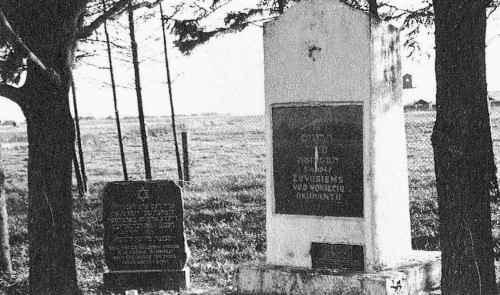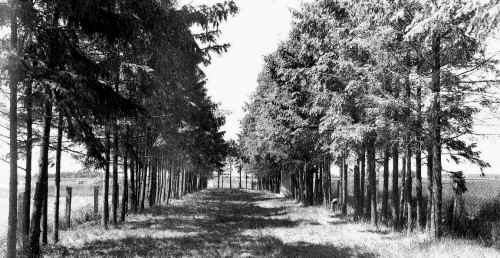 |
 |
The mass grave and the monument, near the village of Pestinukai about 1.5 km from Krakes
|
|
55°34' 23°38'
Grinkiskis (Grinkishok in Yiddish) is a town in central Lithuania, about 35 km. northwest of the district administrative center of Kedainiai, sprawling on the shores of the Susve River. An estate under the name Grinkiskis was mentioned in historical documents dating back to the sixteenth century. During the Russian rule (1795–1915), the town was included under the jurisdiction of the Vilna Province (Gubernia), and since 1843, in the Kovno Gubernia. In the middle of the nineteenth century, Grinkishok became a county administrative center. The town maintained its status during the period of Independent Lithuania (1918–1940). During that period, in addition to the county offices, thirty shops and ateliers were maintained by local business people. During World War I the town was almost totally destroyed by heavy military action.
Old documents of the seventeenth century mention a wooden synagogue in Grinkishok, proving that at that time there was already a Jewish community in this town. Jews made their living in commerce, crafts and agriculture.
The list of contributors for the victims of the famine in Persia in 1871–1872 included 67 names of Grinkishok Jews, as published in the Hebrew newspaper HaMagid (see Appendix 1).
On the list of contributors for The Settlement of Eretz–Yisrael, names of 33 Grinkishok Jews appear, as published in the Hebrew newspaper HaMelitz (see Appendix 2).
In 1886 there were 558 Jewish residents, and by 1897 the numbers had swelled to 924. In spite of impressive growth of the Grinkishok population in the second half of the nineteenth century, the economic situation of the Jews was difficult. A report published by a local man in HaMelitz in May 1883 stated that during the last two years there were no candles in the Beth Midrash and no heating fuel, and the Gabaim's efforts to raise money were fruitless because the “buyers” of the aliyoth latorah were not able to pay. The situation was so bad, that a policeman would collect the debts on behalf of the authorities.
A year before, the same newspaper announced that a Gemiluth Hesed society had been established in Grinkishok by the initiative of a young learned man Falek Kantorovitz.
The community had its own cemetery and a Heder as well as its own Shohet who also provided services to the nearby community of Beisagole (Baisogala).
[Page 44]
Rabbi Aryeh–Leib Duber ben Tsevi–Hirsh HaLevi Volpert served in Grinkishok from 1872 until World War I. From 1934, the official rabbi of the town was Meir–Leib Matz. He was also the last rabbi of that community and was murdered by the Lithuanians in 1941.
In 1921, four years after the establishment of Independent Lithuania, there were 250 Jewish persons living in Grinkishok. In the elections for the first Seimas (Parliament) of Lithuania in 1922, 130 Grinkishok Jews cast their votes for the Jewish lists: 84 voted for the Zionists, 38 for Akhduth (Agudath–Yisrael) and 8 for the Democrats.
According to the first population census, conducted by the government in 1923, there were 972 residents in town, of whom 235 (24%) were identified as Jews.
During that period, just as before the war, Jews derived their livelihood from shopkeeping and trades. Commercial activities took place mainly on a Tuesday, which was the weekly market day. According to the Government survey conducted in 1931, Jews of Grinkishok owned seven shops: three textile shops, two butchers, one watchmaker and jeweler, and one shop selling Singer sewing machines. The Jews also owned two flourmills and a bakery. In 1937, there were eight Jewish tradespeople: four butchers, one baker, one barber, one tailor and one photographer.
In 1939, there were 20 telephone subscribers in Grinkishok; four of them were Jewish.
A segment of Grinkishok Jews were supporters of the Zionist movement.
The results of the elections to the Zionist congresses are given in the table below:
| Congress No. |
Year | Total Shkalim | Total Votes | Labor Party
|
Revisionists | General Zionists
|
Grosmanists | Mizrahi | ||||||
| 16 | 1929 | 9 | 9 | — | — | 5 | 4 | — | — | — | ||||
| 17 | 1931 | 8 | 8 | — | — | 7 | — | — | — | 1 | ||||
| 18 | 1933 | — | 51 | 27 | — | 6 | — | 17 | 1 | |||||
| 19 | 1935 | — | 22 | 12 | — | — | 9 | — | 1 | |||||
Among the Zionist youth organizations, Benei–Akiva is listed as an active one.
[Page 45]
During the Soviet rule (1940–1941), Zionist activity was forbidden and several businesses were nationalized, including Jewish businesses.
When the German army invaded the Soviet Union on June 22nd, 1941, there were still twenty Jewish families living in Grinkishok. At the end of August 1941, armed Lithuanians led all the Jews to the nearby town of Krok (Krakes), and there, on September 2nd, 1941 (10th of Elul, 5701) they were murdered together with the Jews of Krakes and the surrounding areas.
Sources:
Yad Vashem archives, Jerusalem; M–9/15(6)
Gotlib – Ohalei Sheim, page 34
HaMelitz, St. Petersburg; 28.5.1883; 12.11.1884
[Page 46]
|
|
|
|
The mass grave and the monument, near the village of Pestinukai about 1.5 km from Krakes |
[Pages 47-49]
A List of 67 Grinkishok donors for the victims of the Persian Famine in 1872
as published in HaMagid in 1872
(JewishGen. Org. Databases, compiled by Jeffery Maynard)
| Surname | Given Name | Comments |
| BROIDA | Chaim Tzvi | Rabbi Gaon |
| HACOHEN | Eliezer Chaim | |
| HACOHEN | Yitzhok | |
| HALEVI | Zelig | |
| KAPLAN | Boruch | boy |
| KAPLAN | Meir ben Yoel | |
| KAPLAN | Toba bas Yuda Eliezer | woman |
| KAPLAN | Yehuda Eliezer ben Yoel | |
| KAPLAN | Yitzchok ben Y | |
| KAPLAN | Yosef ben Yoel | |
| KAPLAN | Zev | |
| KATZ | Meir ben Avraham | |
| KIRANEL | Yisroel | |
| KOBELUNA | Toba | |
| MILNER | Dovid ben Dov | |
| ROFE | Ari | |
| SANDLER | Aharon ben Yosef | |
| SANDLER | Dov | |
| SANDLER | Leib | |
| VILENTZIG | Shalom | |
| WEINER | Dovid | |
| WEINER | Meir ben Yitzchok | |
| WEINER | Reuven ben Yuda | |
| YAKOBZOHN | Yakov Noson | |
| ZAK | Moshe ben Shlomo | |
| Aharon ben Tzvi Yitzchok | ||
| Avraham Note ben Yisroel | ||
| Boruch ben Binyomin | ||
| Dov ben Yakov | boy | |
| Dov son of Rabbi Yechezkel | ||
| Dovid ben Yosef | boy | |
| Eli ben Meir | brother of Tzvi | |
| Eli ben Moshe | ||
| Eliezer ben Moshe | ||
| Eliezer ben Shlomo | ||
| Ita | woman | |
| Kalman ben Nachum | boy | |
| Leib ben Yitzchok | ||
| Meir ben Yehuda | father of Yehuda Leib | |
| Meir Tzvi ben Moshe | ||
| Menachem ben Avraham | ||
| Mordechai ben Yehoshua | ||
| Moshe ben Yakov | ||
| Nachum ben Yosef | ||
| Shalom Meir | nephew of Eli ben Meir | |
| Shimon ben Shalom | ||
| Shlomo ben Yehuda | ||
| Shmuel ben Yosef | ||
| Shraga Mordechai ben Eli | ||
| Tanchum ben Yehuda | ||
| Tzvi ben Meir | brother of Eli | |
| Tzvi Hirsh ben Nachum | s–i–l of the Rabbi | |
| Yakov Reuven ben Tzvi | ||
| Yakov Shraga ben Yuda | ||
| Yakov Yechiel ben Avraham | ||
| Yechezkel ben Shlomo | ||
| Yechiel ben Shmariahu | ||
| Yehuda Leib ben Meir ben Yehuda | ||
| Yehuda Leib ben Tzvi | from Kairenai (Kiran) | |
| Yisroel Yehuda | Sha”tz & Shu”b | |
| Yosef Dov ben Moshe | ||
| Yosef Meir ben Yehuda | ||
| Yuda ben Yakov | ||
| Yuda Eliezer | wife of | |
| Zadok ben Yosef | boy | |
| Zalman ben Yakov | ||
| Zev ben Yechezkel |
[Pages 50-51]
A List of 33 Grinkishok contributors for the benefit of Settlement of Eretz Yisrael,
as published in HaMelitz in the years 1898–1902
(JewishGen. Org. Databases, compiled by Jeffery Maynard)
Note: Under “Source” all are from the publication “Hamelitz.”
| Surname | Given Name | Comments | Source | Year |
| KAPLAN | Boruch | in Johannesburg, SA | #102 | 1898 |
| WOLPERT | Ari Leib | ravbbi gaon ABD | #137 | 1900 |
| WOLPERT | Ari Leib | ravbbi gaon ABD | #137 | 1900 |
| YAKOBZOHN | Shmuel Yitzchok | in Johannesburg, SA | #102 | 1898 |
| YAKOBZOHN | Tzvi Hirsh | in Johannesburg, SA | #102 | 1898 |
| BREGMAN | Moshe | #232 | 1902 | |
| BREGMAN | Zev | #232 | 1902 | |
| BRUK | Yisroel | #233 | 1902 | |
| COHEN | Moshe | from Gilwan | #233 | 1902 |
| COHEN | Moshe husband of Chaya Lipshitz | wed 14 Elul in Grinkiskis | #232 | 1902 |
| GLIK | Meir | #232 | 1902 | |
| GORDON | Avraham Yosef | #232 | 1902 | |
| HEILIGMAN | Gershon | shu”b | #232 | 1902 |
| KAPLAN | B | #232 | 1902 | |
| KAPLAN | Shmuel Binyomin | #233 | 1902 | |
| KIRSHTEIN | Aharon | #232 | 1902 | |
| KIRSHTEIN | Miriam | #232 | 1902 | |
| KIRSHTEIN | Tuvia | #232 | 1902 | |
| LIPSHITZ | Chaya wife of Moshe Cohen | wed 14 Elul in Grinkiskis | #232 | 1902 |
| LUBIANTZKIN | Z | from Keidan | #233 | 1902 |
| MAGID | Rochel | #232 | 1902 | |
| MARKAN | Sarah | #232 | 1902 | |
| MARKN | Avraham Yitzhok | #233 | 1902 | |
| MOLK | Yosef | #233 | 1902 | |
| PROK | Yosef | #232 | 1902 | |
| SANDLER | Matitiahu | #232 | 1902 | |
| WEIGER | Yisroel | #233 | 1902 | |
| WEINER | Leib | #232 | 1902 | |
| WEINER | Tzipa | #232 | 1902 | |
| WEINER | Yisroel | #232 | 1902 | |
| YAKOBSON | Mani | #232 | 1902 | |
| YOSELOWITZ | Yitzchok | #232 | 1902 | |
| YOTKIN | Zalkind Leib | #232 | 1902 |
|
|
JewishGen, Inc. makes no representations regarding the accuracy of the translation.The reader may wish to refer to the original material for verification.
JewishGen is not responsible for inaccuracies or omissions in the original work and cannot rewrite or edit the text to correct inaccuracies and/or omissions.
Our mission is to produce a translation of the original work and we cannot verify the accuracy of statements or alter facts cited.
 Protecting Our Litvak Heritage
Protecting Our Litvak Heritage
 Yizkor Book Project
Yizkor Book Project
 JewishGen Home Page
JewishGen Home Page
Copyright © 1999-2026 by JewishGen, Inc.
Updated 02 Jan 2019 by JH